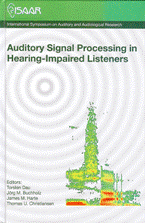Effects of amplitude ramps on phonemic restoration of compressed speech with normal-hearing and hearing-impaired listeners
Abstract
Continuity illusion refers to the phenomenon where an interrupted signal is perceived as continuous, once the silent interval is filled with a louder sound. A similar mechanism is believed to help with phonemic restoration of missing speech segments. When speech segments are not audible due to masking of interfering background sounds, listeners may fill in the gaps and have enhanced speech intelligibility, even when those segments are omitted. For example, as a special case of phonemic restoration, it was shown that recognition of gated sentences was better when the silent intervals were filled with loud noise bursts. The present study is a preliminary attempt in exploring hearing aid processing effects on complex listening tasks that are likely to occur in real life, such as restoration of obliterated speech. Specifically, we explored if phonemic restoration might be degraded due to hearing aid compression, which might produce ramps on the speech envelope during the recovery from compression following the loud noise bursts lling the gaps. In Experiment 1, phonemic restoration was measured with normal-hearing (NH) listeners where ramps of var- ying durations were added on the speech envelope after the noise intervals, to simulate recovery from compression. Phonemic restoration was significantly reduced as the duration of the ramps increased. Experiment 2 shows preliminary results with hearing-impaired (HI) listeners, where phonemic restoration was measured for a number of configurations. The results showed a large variability in phonemic restoration by HI listeners, and audibility and gating period were observed to be important factors affecting the results. The combined results imply that hearing aid compression might have detrimental effects on phonemic restoration; however, more data is needed to determine how applicable these results would be to HI listeners.
References
Institute of Electrical and Electronics Engineers (1969). IEEE recommended practice for speech quality measurements.
Nilsson, M., Soli, S., and Sullivan, J. (1994). “Development of the Hearing in Noise Test for the measurement of speech reception thresholds in quiet and noise,” J. Acoust. Soc. Amer. 95, 1085-1099.
Powers, G. L., and Wilcox, J. .C. (1977). “Intelligibility of temporally interrupted speech with and without intervening noise,” J. Acoust. Soc. Am. 61, 195-199.
Warren, R. M. (1970). “Perceptual restoration of missing speech sounds,” Science, 167, 392-393.
Warren, R. M., Obusek, C. J., and Ackroff, J. M. (1972). “Auditory induction: Perceptual synthesis of absent sounds,” Science 176, 1149-1151.
Additional Files
Published
How to Cite
Issue
Section
License
Authors who publish with this journal agree to the following terms:
a. Authors retain copyright* and grant the journal right of first publication with the work simultaneously licensed under a Creative Commons Attribution License that allows others to share the work with an acknowledgement of the work's authorship and initial publication in this journal.
b. Authors are able to enter into separate, additional contractual arrangements for the non-exclusive distribution of the journal's published version of the work (e.g., post it to an institutional repository or publish it in a book), with an acknowledgement of its initial publication in this journal.
c. Authors are permitted and encouraged to post their work online (e.g., in institutional repositories or on their website) prior to and during the submission process, as it can lead to productive exchanges, as well as earlier and greater citation of published work (See The Effect of Open Access).
*From the 2017 issue onward. The Danavox Jubilee Foundation owns the copyright of all articles published in the 1969-2015 issues. However, authors are still allowed to share the work with an acknowledgement of the work's authorship and initial publication in this journal.


